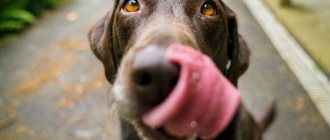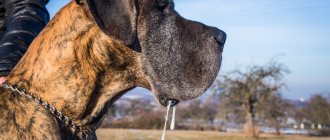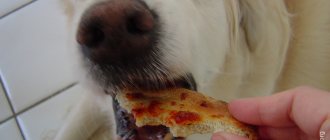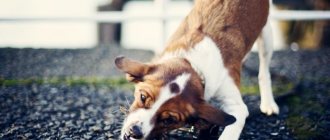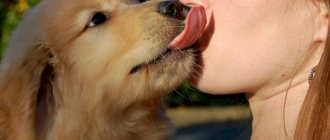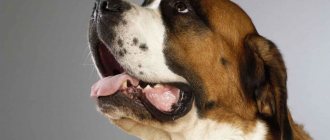Among dogs, as among people, there are small eaters and gluttons. Each owner knows his pet, how much he eats and what foods he likes most. When, for unknown reasons, a pet eats poorly or completely refuses food, even previously loved food, this should be a cause for concern for the owner. Let's figure out how to increase a dog's appetite and determine the reasons for its absence, in which cases you can cope on your own, and when you should seek qualified help.
Causes of lack of appetite
There can be many reasons for decreased appetite or loss of appetite in dogs, but they all fall into two categories: behavioral and physiological.
Behavioral
If a hunger strike is declared without visible symptoms of illness, this is most likely a behavioral disorder. It can be caused by any event in the dog’s life that does not fit into the framework of normal life:
- a change of environment caused by a move, a strange apartment, new smells, interior items can cause a psychological reaction in impressionable pets, discomfort, and refusal to eat;
- separation from the owner - a vacation or a long business trip during which the dog is left in foster care or with friends; illness or death of the owner often causes a depressed psychological state, depression, loss of appetite;
- the appearance of a new family member in the house - a wedding or the birth of a child can provoke jealousy, depression, apathy, and refusal to eat;
- the appearance of another pet - the decision to get another dog, cat or any other pet can be perceived as a personal insult, causing jealousy, depression, a desire to hide from everyone, and lack of appetite;
- increased attention - if the dog does not have the opportunity to eat in peace, someone is constantly nearby or there are distractions;
- the need to share a bowl with another pet can also cause a decrease in appetite;
- odor – a poorly washed bowl or a strong smell of detergent can discourage you from eating from it.
Apart from perhaps a slight lethargy, this behavior has no obvious external signs.
Physiological
A dog's loss of appetite is often directly related to a health condition. Symptoms characteristic of a particular illness help determine the true reason why a pet refuses to eat:
- Worm infestation and parasites - the dog is lethargic, apathetic, and may refuse not only food, but also long walks. Digestive upset appears in the form of vomiting and loose stools. The quality of the wool deteriorates, it becomes dull and dry.
- Poisoning – food poisoning from low-quality products causes vomiting, stomach upset, refusal to eat, and in severe cases, weight loss. This is a short-term phenomenon and, if timely measures are taken, does not pose a threat to the life of the animal.
- Improperly formulated diet - prolonged consumption of food high in protein is manifested by external signs, such as changes in the color and smell of urine, the appearance of dandruff, and bald patches on the ridge and tail. In advanced forms it can lead to kidney failure.
- Intoxication with chemical or medicinal substances is a severe, fast-acting form of poisoning that causes a reaction in the gastrointestinal tract, cardiovascular and central nervous systems.
- Enteritis is an infectious intestinal disease that in most cases affects puppies and adolescents under one year of age. Refusal of food is accompanied by lethargy, refusal of water, and fever. The dog reacts painfully to pressure in the stomach area and tucks its tail. In its advanced form, uncontrollable vomiting and diarrhea with a strong unpleasant odor appear.
- Diseases of the oral cavity - inflammation of the gums, mucous membranes, stomatitis, caries, gingivitis, periodontitis and periodontal disease cause the dog discomfort and even pain while eating, which can make him refuse food. The appearance of an odor from the mouth, drooling, reddening of the gums or inflammation of the lymph nodes are symptoms of these diseases.
- It happens that loss of appetite becomes the first symptom of the development of serious diseases, such as oncological, endocrinological, cardiac and pulmonary.
If your pet exhibits any of the above signs, contact your veterinarian immediately.
Diet for an exhausted dog
The easiest way is to feed your dog natural food - it is tasty and smells appetizing. The basis of the diet is meat - 75-80% of the total weight of food per day. From meat, the dog will receive essential amino acids that cannot be obtained from plant foods. Plant foods will account for the remaining 20-25% of the diet. The basic principle of diet formation is maximum calorie content. The food should have the consistency of liquid porridge.
Fatty meat should not be given to an emaciated dog, so as not to cause problems with the gastrointestinal tract. Instead of pork, dietary varieties are suitable - chicken, turkey, rabbit, as well as veal and horse meat. The meat is boiled for better digestibility. By-products are less nutritious and less digestible. From by-products, boiled liver is given 2 times a week, replacing up to a third of the total volume of meat per day.
Plant foods allowed for an exhausted dog are cereals, vegetables that can be mixed with meat. Buckwheat and rice porridge are cooked in meat broth diluted with water without salt, oatmeal and corn grits are given. It is not recommended to give semolina and millet. A tasty dish will be made from porridge mixed with chopped meat and heat-treated vegetables - carrots, beets. Every week, give your pet boiled low-fat fish with the bones removed, and boiled eggs. Clean, fresh water should always be readily available.
If your dog eats ready-made store-bought food, then choose the highest quality premium food. Wet food will also work. And so that your dog doesn’t get tired of the monotony of tastes, mix ready-made food with boiled meat, fish, eggs, grated cheese or fermented milk products - cottage cheese, sour cream, low-fat kefir. Dry food is contraindicated for an exhausted dog; it will only worsen health problems. It is allowed to be given only after recovery.
Natural causes
A common reason for refusing to eat is the food itself. Just like people, dogs have eating habits, preferences, favorite and disliked foods. Your pet may suddenly be picky when choosing food. If you pamper your pet with treats from your table, then over time this can lead to the fact that the dog will ignore his bowl, expecting treats from you.
A sudden change in the usual diet (natural to dry food and vice versa) can lead to rejection of new food and, accordingly, partial or complete loss of appetite. Also, too large or very small fractions of food may not suit the dog, which will lead to refusal.
Older dogs and dogs with insufficient exercise require less energy and therefore less food. Failure to comply with the diet (overfeeding) and resulting refusal of food should not be confused with a deterioration in appetite. Many pets eat significantly less during the hot season. A bitch during estrus and before giving birth can also eat very little. Often after vaccination, the dog loses its appetite and looks a little lethargic for 1-3 days. If after this time the pet returns to its normal mood and desire to eat tasty food, then everything is fine.
What can you do?
- Take a closer look at the dog’s well-being, at its lifestyle, to see if anything has appeared that distracts, interferes with, or stresses it out. Try to reduce or remove possible unnecessary stressors. Don't distract her while she eats. Eliminate any negative factor at this time. Do not scold or praise near the bowl. Any encouragement is permissible only after eating.
- Examine the dog's mouth and the condition of its teeth. Usually it is not difficult to notice damage, swelling, and inflammation. Sometimes changing the size of the granules can help. Your dog may not be able to eat pellets that are too large.
- Establish a consistent feeding schedule. Do not change food frequently. You should not take risks by buying food at a discount at a promotion, which is already approaching its sell-by date. Or buy a huge bag for the future for a small dog. Get a special container for closed food storage.
- Provide your pet with active walks with games and physical activity. Do training exercises.
- Do not give your pet food from the table - only in his bowl. During meals, the owner and his family should send the dog to its place. And do not give in to plaintive pleading glances, sighs and other gestures. If the dog persists, show firmness and persistence.
- Leave food in the bowl for no more than 15 minutes, after which the bowl should be removed until the next feeding. No matter how much is eaten.
- If there are several dogs, it is better to feed them separately.
What to do if the dog doesn't eat
If there are no visible reasons for concern or obvious symptoms of illness, you should try to increase your dog’s appetite on your own. First of all, it is important to establish a correct and strict feeding regimen. The number of meals and the interval between them depends on the age of the pet. An adult dog needs two times a day, at approximately equal intervals. At the same time, it is necessary to limit free access to food. That is, the bowl should be in front of the dog for 20-30 minutes. If during this time the pet has not eaten the entire portion, remove it. A few days of this regime will teach the dog to eat at the time when food is given to it.
How to increase the desire to eat dry food? You can diversify it, enhancing the smell and taste. Add a few spoons of wet food or special meat sauce for animals to the regular portion. You can pour a little warm water into the bowl to soften the dryer slightly. Store granules at room temperature in a tightly closed container. If stored improperly, dry food loses its smell and attractiveness to the animal. Try changing the brand of food. But this needs to be done gradually, replacing a small portion of the portion at each feeding. The transition may take 7-10 days.
Try to diversify your natural diet by changing combinations of products and their quantities in a serving. Offer your pet's favorite foods in small quantities along with other ingredients. Alternate food - do not give the same thing 2 or more times in a row. Using the elimination method, remove foods that your dog does not like from the diet.
How to increase a dog's appetite if there are several pets in the house? Try feeding her separately from the others - in a different room or at a different time. Although in some cases it is competition that forces pets to eat their entire portion. A radical method that is not suitable for every owner of a four-legged friend is fasting. The dog is given only water for 24 hours. As a rule, after this the pet happily eats its portion. As a last resort, you can skip only one feeding.
You can increase the appetite of a healthy dog by increasing physical activity - a long walk and active play in the fresh air require a lot of energy. The dog will definitely be hungry and eat well when he returns home.
How to improve your dog's nutrition at home?
First, let’s try to diagnose the problems in our pet ourselves. Carefully examine the oral cavity, check for ulcers, inflammation, tumors, and damaged teeth. Do the same with the eyes and ears; there should be no discharge, redness, swelling, etc. Examine the dog's body for signs of parasites or injuries. If none of the above was found, then you can try to fix the problem yourself.
But remember, this is only relevant if the period of food refusal does not last long.
How the owner can influence the situation:
- Normalize your diet. Give your dog familiar and tasty food.
- Avoid snacking and eating food from other animals.
- Take him for a walk more often and increase the number of active games.
- Buy a new toy.
- Limit stress.
- Do not allow your pet to take anything from the ground outside.
- Limit contact with sick animals, if any.
When to contact a veterinarian
If a dog refuses his favorite treat, does not eat for no apparent reason (all of the above) for 2 days, this is a reason to contact a veterinarian. The doctor will examine the mouth, throat, palpate the abdomen, do an ultrasound if necessary, and take blood tests. This will help identify the cause of the lack of appetite.
You can increase your appetite during illness by using medications aimed at eliminating the cause and symptoms of the disease. Only the attending physician who is familiar with the picture of the disease and the current condition of the dog can prescribe medications.
After an illness, a vitamin complex and a special diet prescribed by your doctor will help restore your appetite and gain weight.
When is a veterinarian needed?
A visit to the veterinary clinic is necessary in the following situations:
- Positive visual inspection. If, when analyzing your pet’s condition, you still find some pathological discharge, ulcers, rashes, injuries, swelling, etc.
- Prolonged fasting.
- Aggressive behavior of the animal.
- Diarrhea or other gastrointestinal disorders.
- Weight loss.
- Cough, difficulty breathing.
- Bleeding.
- Lack of urination.
- Bad breath.
- Profuse drooling.
- Lethargy, inability to move, forced position.
- Pathological hair loss.
- Any other cause for concern (seems like something was swallowed).
The doctor will conduct laboratory and instrumental examinations for your pet in order to clearly identify existing problems and select an appropriate treatment plan, and the Gomeovet Veterinary Pharmacy and Pet Store will help you buy all the necessary medications and toys so that recovery is not only high-quality, but also fun.
Remember that the health and happy life of your pet depends on you.
Pet's spoiling
Far from being the least important reason would be arrogance. The pet is extremely demanding and is confident that you will feed it, in particular from your hands, and even better from the table, with harmful but tasty treats. Pampering is manifested in inviolability of the bowl and subsequent sitting and begging for food at the master's table. To solve this problem, it is enough to completely eliminate complementary feeding with all sorts of goodies. Leave the bowl of food for literally fifteen minutes; if you haven’t eaten it, then remove the bowl until the next meal.
Dirty or alien
A puppy may refuse to eat from a bowl if it smells foreign or simply unfamiliar and unpleasant odors. A typical situation: you washed the bowl using detergent, but you didn’t wash it well enough, which is why the dog smells chemicals and refuses to eat from such dishes.
There are cases when pets are very respectful and kind to other people's property and prefer to eat exclusively from their own bowl. In these cases, it will be enough to wash and rinse the bowl well in order to get rid of foreign odors.
How to train a puppy to eat: exchange option
If a small puppy is actively protecting the bone, it is necessary that he master the technique of standing in a sitting position before starting feeding (we talked about it above). Another option is also possible: exchanging a bone for a toy, a piece of cheese, cookies or another bone, but only under one condition - not according to the principle “you - to me, I - to you,” but according to a completely different scenario.
Before you teach the puppy to eat, you show the puppy a toy (a piece of meat, cheese, cookies) and at the same time say his name. If the puppy becomes interested in a toy or treat and throws a bone or comes up to you with it, you need to bring the object that interests it to the dog’s nose and command “Sit!” and on the command “Give!” carefully pick up the bone, and then reward the puppy with a toy (treat). After 5-10 s, saying the command “Hold!” (“Okay!”, “Eat!”) give the bone to the puppy. Remember: the treat is given to the dog specifically for boarding, and not in exchange for a bone. The sooner you start on the command “Give!” forcing the puppy to give up the bone, the better.
Diet and portion sizes
An exhausted dog needs correction not only of its diet, but also of its regime. Follow two basic principles:
- number of meals – from 3 to 8 times a day;
Small meals for cachexia are mandatory. If the dog has obvious health problems, then in the first two weeks a schedule of five meals a day is established, then for two weeks the dog switches to four meals a day. As a result, after a month the number of feedings is reduced to three. If the dog is not sick, but simply exhausted, then after another two weeks, transfer him to standard two meals a day - breakfast and dinner.
For old and sick dogs, natural feeding is prescribed and it will remain fractional for the rest of their lives. To prevent a dog at an advanced age from spending too much energy on eating food, distribute the daily intake over four feedings. Older dogs tend to eat one serving at a time.
- increase feed by 10% every 2-3 days.
You cannot sharply increase the amount of food so as not to provoke intestinal problems. The “additional” 10% is either distributed among all portions, or additional feeding is done if the dog is severely exhausted. You should not overfeed your pet, especially if he has significant weight loss! If in doubt about servings, consult your veterinarian.
